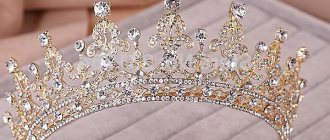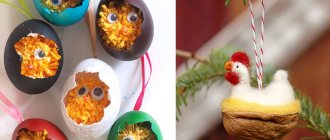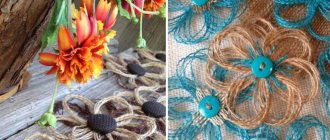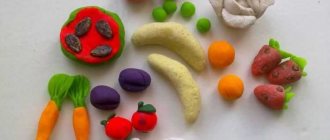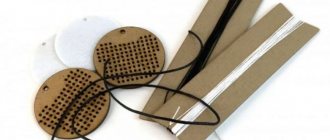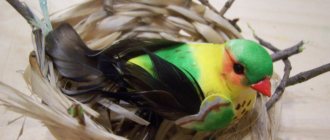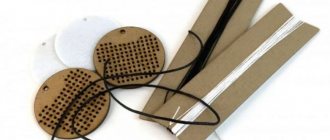Comfort, convenience and style are the three pillars on which the design of any house or apartment is based. As you know, a cozy homely atmosphere, which you so want to immerse yourself in after a hard day at work, consists of seemingly insignificant little things and details. Some people use the services of a designer to create the long-awaited feeling of a cozy home, while others try to create a miracle with their own hands.
DIY chandelier
If you also decide to change something in your home, to add a touch of stylish originality to the design of your home, then we offer you a detailed master class “Lampshade made of threads and a balloon.” Threaded balls will look very impressive both in a minimalist living room and in a bright children's room, where there is a magical mess.
Also, the advantage of this idea is that you will have to spend a minimum on the product. A thread lampshade will cost mere pennies, but it will look like a stylish, unusual and effective designer decoration.
You can make one large globe lampshade and hang it in your living room. You can make several small ball lamps and decorate your bedroom with them. White balls without light bulbs can be just a stylish addition to your New Year's decor. There are a lot of options. If you choose the right colors and sizes, and show a little imagination, then a thread lampshade will fit very harmoniously into any interior.
Tools and materials
Before starting creative work on a future chandelier, you need to prepare everything you need. You will need metal wire, threads of the required thickness, fabric, as well as auxiliary tools:
- scissors;
- gloves – medical, rubber, rubber;
- a good quality balloon or other base;
- vegetable oil, Vaseline or fatty cream;
- felt-tip pen;
- a couple of electrical sockets in case you can’t make the correct connection the first time;
- PVC or wallpaper glue;
- light bulb – better LED;
- container for glue.
The selection of materials depends on the specific model of the lamp.
What you will need
- In order to make a lampshade from threads, you will need a regular balloon. Try to choose high-quality balloons that will not burst the first time they enter the air cavity.
- You will also have to rummage through your yarn reserves and choose the color of thread that will fit perfectly into the interior and match the furniture or any other details in the room. For a ball with a diameter of forty centimeters you will need about three standard skeins of yarn.
- To glue threads, many advise using special wallpaper glue or starch-based glue. But how to make a lampshade from threads and a ball with your own hands if you don’t have these materials at hand? The answer is simple - don’t spend money, don’t give up and don’t run straight to the store. Take a look at your child’s office; there probably is a large supply of regular school PVA glue. It is perfect for gluing yarn to the surface of the ball.
- Scissors.
- Also stock up on rubber gloves. There is quite a lot of work to be done with sticky glue.
- Glue container.
- Brush for spreading glue.
- Lighting fixtures, wire for hanging the finished product from the ceiling and a light bulb (regular or energy-saving, not heating up).
Useful tips for choosing lamps
Be careful when choosing lamps for lampshades made of threads, since glue, varnish, and threads are flammable materials. They should be kept away from sources of high temperatures and open flames. Therefore, discard the old model incandescent lamp and opt for a fluorescent or LED lamp. They heat up slightly and consume less electricity, and their lighting intensity is higher.
The retail chain has a large selection of LED lamps, both in size and current consumption. A 9 W lamp produces the same light intensity as a 60 W incandescent lamp. They cost more, but with long-term use the savings on energy consumption are obvious. And the most important advantage is that the risk of fire is reduced.
Very often our taste preferences do not find options when choosing chandeliers, lamps or sconces in stores. In this case, you can create an interesting interior object with your own hands, using the proposed ideas and tips.
Remembering elementary school
Do you remember how at school they made animals using the papier-mâché method? But if back then we used ordinary sheets of paper, applying them to a mold soaked in glue, now paper will be replaced by yarn.
Pour the glue into a specially prepared spacious container. We put on rubber gloves to protect the manicure and skin of the hands from the effects of glue. We begin to dip the yarn gradually into glue. You could even say that it’s not just dipping, but soaking the threads. They should be very well saturated with it.
Some people use glue in jars. Make a hole there and pass a thread through it. There are a lot of options on the Internet on how to wet threads and how to make a lampshade from threads with your own hands. The master class we offer recommends using a glue container.
According to the advice of experts, according to individual reviews of housewives who have already decorated their homes with lamps made from threads, this is a more convenient option. In addition, soaking all the threads at once is much more convenient than sitting and passing three skeins through a jar of glue. Saving time and effort is no small matter.
Options for homemade thread lights
Before you start making a homemade lighting device out of yarn, you need to decide on its design and design solution. The choice of consumables for creating the frame of a lampshade or lampshade, as well as the amount of yarn required, will depend on these two points.
A chandelier made of threads can be made in two versions:
- Shade;
- Ball.
A ball-shaped product is the simplest option. This will require a minimum amount of materials and time.
To create a lampshade, you first need to prepare a metal frame made of thin wire.
Attach the thread
When the thread is well saturated with glue, it can be attached to the ball. First, we fix it at the base of the ball. Knit tightly, make knots. Don't be afraid that the thread will stand out at the top or the ends will stick out noticeably. After everything is dry, unnecessary parts can simply be removed using scissors.
And now comes the most creative moment. When the base of the thread and the ball are firmly tied together, you can begin to wind the thread around the ball itself. You can do this in any order. The appearance of the lampshade will depend on the size of the thread you chose, its color and the winding option.
Tip: if you are making a lampshade from threads and a ball for the living room or children's room, where there should be more light, then try to wind the threads not too close to each other. So the weaving will be chaotic, but not continuous. If the lampshade is being prepared to create a romantic atmosphere in the bedroom, then you can “darken” it, that is, wind the threads more tightly together.
When to stop? We recommend winding the thread until the ball is almost completely out of sight. As a rule, four to five layers of thread are enough for this. Also try to ensure that the end of the winding is on the top of the ball. This is where you will secure the end of the thread.
For extra strength, you can walk over the wound threads with a layer of PVA glue, applying it with a brush.
How we do it
A spherical table lamp should be made according to the following scheme:
Inflated balloon
- inflate the balloons. It’s better to inflate several at once to test the balls’ strength. Balls should be round, not shaped;
- the diameter of the inflated balls should be approximately 40 cm. But this parameter can be anything, depending on the dimensions of the lamp;
- on the ball we draw a circle with a felt-tip pen, through which the resulting lampshade in the shape of a ball will be placed on the lighting fixture;
- We put oilcloth on the table on which we will work so as not to stain the work surface with glue;
- prepare a glue solution;
- After this, we put rubber gloves on our hands and dip the prepared threads into the resulting adhesive solution, wetting them well in the glue. You need to give the threads some time (but not much) to soak in the glue;
Preparing the threads
- then carefully remove the threads from the glue and remove the excess solution. To do this, squeeze out the excess adhesive from the threads with your fingers;
- then we tie the edge of the thread to the ball and begin to carefully wrap the ball with thread. The winding should be done randomly to give the sphere more uniqueness. Although, when using several multi-colored threads, you can try to create a certain pattern with your own hands;
- The degree of thread wrapping depends on the kind of glow the lamp should emit. The more threads you
Winding processwrap it around an inflated balloon, the darker the lampshade will be;
Note! Avoid the appearance of bulges on the ball. The threads must be wound evenly over its entire surface.*
- during the winding process, do not go beyond the boundaries of the outlined circle. Of course, you can make a slot for a light bulb after completion of the work, but in such a situation there is
Ready lamprisk of damaging the lampshade.
After this, you need to give the product time for the glue to dry completely. This may take one night. To prevent damage and deformation, it is better to hang the ball. Only when all the threads are completely dry can you pierce the ball and carefully remove it from the resulting lampshade. Now all that remains is to decorate our homemade lampshade and install it on the leg of the table lamp.
First, you should practice making simpler shapes, and then you can safely move on to more complex designs. The ball shape in this situation will be the easiest to implement.
Let there be light!
So, you already know how to make a lampshade from threads and a ball. There is little left to do - fix our product on the ceiling. To do this, take a light bulb and screw it into the lighting fixture. Secure the fittings using pipe cleaners inside the lampshade. Then it remains to adjust the length of the wire. It is necessary that the lighting element be strictly in the center of your thread creation.
We attach the new light fixture to the ceiling hook. Turn on the light and enjoy your work.
Assembling the electrical part:
If you have an old lamp, then the task is simplified: take all the components and parts from it. But if it is not there, our instructions will help.
Let's prepare a set of materials:
- socket for an electric lamp;
- cartridge holder;
- the wire.
You can assemble such a structure yourself.
Step-by-step instruction:
- We cut a hole in the center of the plastic cover to the size of the cartridge. It is advisable to take a cartridge with external threads and clamping rings. Secure the rings at the top and bottom of the lid.
- We attach the cover with the cartridge to the lampshade.
- We connect the wire from the cartridge contacts to the ceiling terminal.
If you want to make a sconce, table lamp or night light, then connect the wire through the switch to the plug for the electrical outlet.
Additional recommendations
- Choose high-quality glue that will not turn yellow after drying. Otherwise, the color of the threads will change.
- It is not recommended to hang such lighting fixtures in bathrooms and saunas. Humidity in the air can negatively affect the product. The lampshade will simply become wet, the glue will not hold the thread, and the entire structure will fall apart.
- Use additional decorative elements, glue them to already dried threads. Butterflies or stars, petals or flower buds will only add unusualness and style to your product.
- You can also use openwork napkins, lace or light-transmitting fabrics instead of yarn.
Using glass to create lamps
You can hang a composition of several empty liquor bottles on the ceiling. Three-liter jars can be hung by metal chains. Glassware is also suitable as a lampshade. A lamp made from many glass fragments can imitate a crystal chandelier. Broken glass objects find a new purpose in the form of an original lighting fixture. Glasses and wine glasses make beautiful table lamps. Various glass boxes, glass from old wall sconces, headlights, and interior doors may come in handy. A homemade glass chandelier can be painted with watercolor or stained glass paints. You will get beautiful stained glass windows. To create pendant lamps, craftsmen use a variety of decorative containers from oils and perfumes. Unlike wood and paper, glass has high fire safety.
Lighting fixtures made from wine bottles and wood
The list of necessary equipment includes wire cutters, screwdrivers, screws, a glass cutter, silicone, a rag or brush, stain, pine boards, hooks, a chain, ten light bulbs, wiring, and wine bottles. The first step is to process the containers. Labels and remaining glue are removed from the bottles. Using a glass cutter, you need to remove the bottom of each bottle: it rests at a height of 1-2 cm, and the bottle rotates around its axis. The cracks must be tapped with a hammer until the bottom falls off. After this, the electrical wires are placed in bottles and connected to the cartridges. Light bulbs are screwed into them. Now you need to prepare the boards. In the lower, larger one, holes are drilled for necks and wires. The top one will collect them in one bun. Hooks for chains are screwed into the bottom board, which will hold the structure. For the kitchen, you can make a table lamp with a bottle base and a wooden shade.
Popular articles Fleece snail
Using old cans to create lamps
Old jars can find a new purpose. Lamps can be created using threads, electrical wires, and handles for cans. Containers must be equipped with handles. They will need to be tied with threads attached to a pre-prepared iron frame. Electrical wires with sockets and light bulbs are lowered into the jars - the chandelier is ready. You can make an option for the dacha - threads are tied around tree branches, and candles or small lanterns are placed inside the jars. Containers wrapped in multi-colored threads or decorated with patterned napkins look beautiful. The inside of the cans can be painted white, and while it is still wet, apply a pattern in the form of chaotic lines. Some people paint the outside of the container with different paints, and paint an image on top using glitter shadows. Banks can also be lined with small broken glass.
